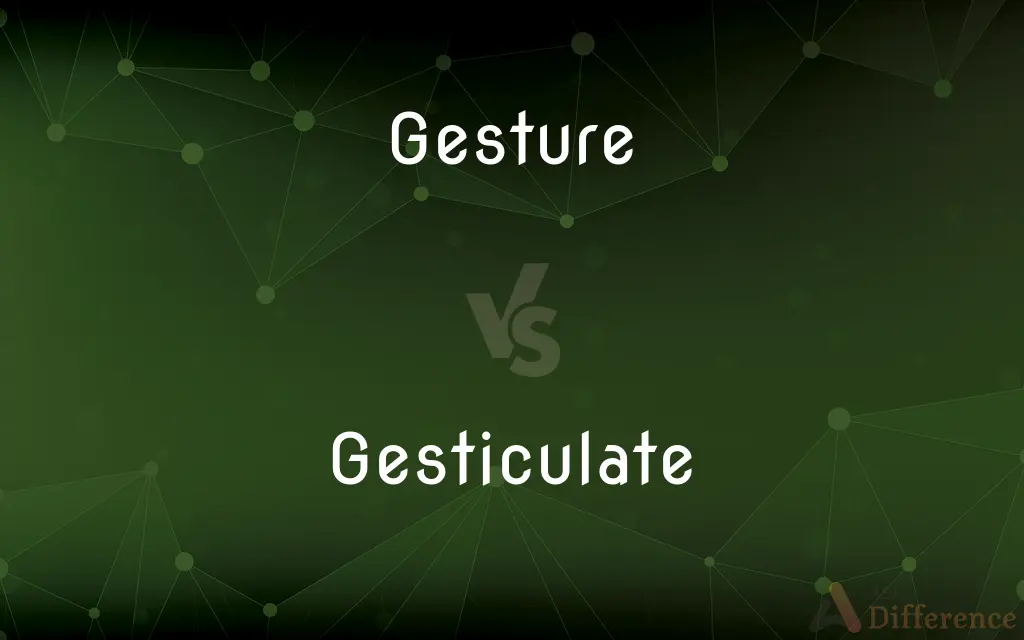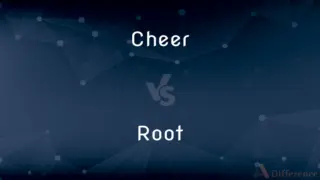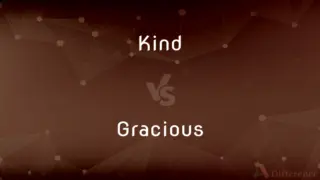Gesture vs. Gesticulate — What's the Difference?
By Tayyaba Rehman & Maham Liaqat — Updated on March 29, 2024
Gesture involves physical movements to express an idea or emotion, while gesticulate means to use dramatic gestures, especially while speaking.

Difference Between Gesture and Gesticulate
Table of Contents
ADVERTISEMENT
Key Differences
A gesture is a form of non-verbal communication where bodily actions, such as hand movements or facial expressions, convey messages or feelings. These actions are often subconscious and can be simple or complex, depending on the context and culture. On the other hand, to gesticulate refers specifically to the act of making gestures, particularly animated or exaggerated ones, usually while speaking or attempting to communicate verbally. Gesticulation is often deliberate and is used to emphasize or enhance the spoken word.
Gestures can range from a thumbs-up signifying approval to a nod indicating agreement. They are integral to human communication, adding nuance and depth to interactions without the use of words. Whereas gesticulating is a more dynamic process, involving a series of movements that are closely tied to speech. This form of expression is especially prevalent in cultures and languages where body language plays a significant role in communication.
While gestures can stand alone as complete messages, such as the peace sign or a wave goodbye, gesticulating usually accompanies verbal communication, serving to underline or illustrate what is being said. This distinction highlights the role of gestures as potentially independent modes of communication, in contrast to gesticulations that support and embellish verbal messages.
In educational or professional presentations, gestures are often carefully planned to aid in conveying information or to keep the audience engaged. These can include pointing to displayed information or using hand movements to illustrate concepts. Gesticulate, however, implies a more spontaneous and energetic use of gestures, often seen in passionate speeches or heated discussions, where the speaker's physical movements are naturally integrated with their words to capture attention and emphasize points.
Understanding the context and cultural background is crucial in interpreting gestures, as their meanings can vary significantly across different societies. For instance, a thumbs-up may be considered positive in some cultures but offensive in others. Gesticulating, while more universally understood as a form of emphasis, can also be perceived differently, with the intensity and type of gestures used varying widely among individuals and cultural contexts.
ADVERTISEMENT
Comparison Chart
Definition
A movement or position of the hand, body, or face that is expressive of an idea, opinion, or emotion.
The act of making gestures, especially dramatic ones.
Communication Type
Can be both non-verbal and verbal communication.
Primarily enhances verbal communication.
Intention
May be subconscious or deliberate.
Typically deliberate and often exaggerated.
Context of Use
Can convey a complete message independently.
Usually accompanies speech to emphasize or illustrate points.
Cultural Variability
High, with meanings changing across cultures.
Less variable, but intensity and perception can differ culturally.
Compare with Definitions
Gesture
A nod to agree.
She nodded, a simple gesture of agreement.
Gesticulate
Flailing arms while explaining.
He began to gesticulate wildly to make his point.
Gesture
A smile as a friendly greeting.
Her smile was a warm gesture of welcome.
Gesticulate
Pointing vigorously during an argument.
She gesticulated towards the evidence as she spoke.
Gesture
A thumbs-up for approval.
He gave a thumbs-up to show his satisfaction.
Gesticulate
Using hands to emphasize a story.
As he recounted the event, he gesticulated for effect.
Gesture
Waving goodbye.
She waved goodbye to her family from the train.
Gesticulate
Dramatic hand movements in a speech.
The speaker gesticulated to highlight key points.
Gesture
Shrugging to indicate ignorance.
He shrugged, signaling he didn't know the answer.
Gesticulate
Mimicking actions while describing them.
Describing the fight, he gesticulated each punch.
Gesture
A gesture is a form of non-verbal communication or non-vocal communication in which visible bodily actions communicate particular messages, either in place of, or in conjunction with, speech. Gestures include movement of the hands, face, or other parts of the body.
Gesticulate
Use gestures, especially dramatic ones, instead of speaking or to emphasize one's words
They were shouting and gesticulating frantically at drivers who did not slow down
Gesture
A movement of part of the body, especially a hand or the head, to express an idea or meaning
So much is conveyed by gesture
Alex made a gesture of apology
Gesticulate
To make gestures especially while speaking, as for emphasis.
Gesture
Make a gesture
She gestured meaningfully with the pistol
Gesticulate
To say or express by gestures.
Gesture
A motion of the limbs or body made to express or help express thought or to emphasize speech.
Gesticulate
(intransitive) To make gestures or motions, as in speaking.
Gesture
The action of making such a motion or motions
Communicated solely by gesture.
Gesticulate
(transitive) To say or express through gestures.
Gesture
An act or a remark made as a formality or as a sign of intention or attitude
Sent flowers as a gesture of sympathy.
Gesticulate
To make gestures or motions, as in speaking; to use postures.
Gesture
To make gestures.
Gesticulate
To represent by gesture; to act.
Gesture
To show, express, or direct by gestures
Gestured her disapproval.
Gesticulate
Show, express or direct through movement;
He gestured his desire to leave
Gesture
A motion of the limbs or body, especially one made to emphasize speech.
The middle-finger gesture is really a nonverbal swear.
This Web browser can be controlled with mouse gestures.
Gesture
An act or a remark that serves as a formality or as a sign of attitude.
We took flowers as a gesture of sympathy.
Gesture
(GUI) A motion made with a pointing device, or on a touchscreen, that is recognised by the system as a command.
Gesture
(obsolete) The manner of carrying the body; position of the body or limbs; posture.
Gesture
(intransitive) To make a gesture or gestures.
My dad told me never to gesture with my hands when I talk.
Never gesture at someone using your middle finger: it may be perceived as an insult.
Gesture
(transitive) To express something by a gesture or gestures.
He gestured his disgust.
Gesture
(transitive) To accompany or illustrate with gesture or action.
Gesture
Manner of carrying the body; position of the body or limbs; posture.
Accubation, or lying down at meals, was a gesture used by many nations.
Gesture
A motion of the body or limbs expressive of sentiment or passion; any action or posture intended to express an idea or a passion, or to enforce or emphasize an argument, assertion, or opinion.
Humble and reverent gestures.
Grace was in all her steps, heaven in her eye,In every gesture dignity and love.
Gesture
To accompany or illustrate with gesture or action; to gesticulate.
It is not orderly read, nor gestured as beseemeth.
Gesture
To make gestures; to gesticulate.
The players . . . gestured not undecently withal.
Gesture
Motion of hands or body to emphasize or help to express a thought or feeling
Gesture
The use of movements (especially of the hands) to communicate familiar or prearranged signals
Gesture
Something done as an indication of intention;
A political gesture
A gesture of defiance
Gesture
Show, express or direct through movement;
He gestured his desire to leave
Common Curiosities
Can a gesture convey a complete message?
Yes, a gesture can convey a complete message or emotion without the need for words, such as a nod for agreement.
How do gestures vary across cultures?
Gestures can have different meanings in different cultures, making it important to be aware of cultural variations to avoid misunderstandings.
Can gestures replace verbal communication?
In some contexts, gestures can effectively replace words, conveying clear messages through physical actions alone.
Why do people gesticulate when they talk?
People gesticulate to emphasize what they are saying, to help convey their emotions, and to make their communication more engaging.
Is gesticulating always intentional?
Gesticulating is usually intentional and is often used to emphasize or clarify spoken words through physical movements.
Can gesticulating be too much?
Excessive gesticulation can be distracting and may overwhelm the verbal message, so it's important to balance gestures with speech.
Can gestures enhance learning?
Yes, using gestures can enhance learning and retention by providing visual cues that accompany verbal instructions or explanations.
Do gestures have the same meaning everywhere?
No, the meaning of gestures can differ significantly around the world, so a gesture that is positive in one culture may be offensive in another.
What is a gesture?
A gesture is a physical action or movement, often of the hands or face, that expresses an idea or feeling.
What does it mean to gesticulate?
To gesticulate means to make movements, especially with the arms and hands, that are expressive and often accompany verbal communication.
Is it possible to communicate solely with gestures?
While challenging, it is possible to communicate basic ideas and emotions solely through gestures, especially in the absence of a common language.
Why are gestures important in communication?
Gestures are important because they can add emphasis, convey emotion, and aid understanding in communication.
Are gestures universal?
While some gestures are widely recognized, the meaning of gestures can vary greatly across different cultures.
How do children learn gestures?
Children learn gestures through observation and imitation of adults and peers within their cultural and familial environments.
How can one improve their use of gestures in public speaking?
Practice using gestures that feel natural and match the message, observe skilled speakers, and be mindful of the audience's cultural background.
Share Your Discovery

Previous Comparison
Cheer vs. Root
Next Comparison
Kind vs. GraciousAuthor Spotlight
Written by
Tayyaba RehmanTayyaba Rehman is a distinguished writer, currently serving as a primary contributor to askdifference.com. As a researcher in semantics and etymology, Tayyaba's passion for the complexity of languages and their distinctions has found a perfect home on the platform. Tayyaba delves into the intricacies of language, distinguishing between commonly confused words and phrases, thereby providing clarity for readers worldwide.
Co-written by
Maham Liaqat














































